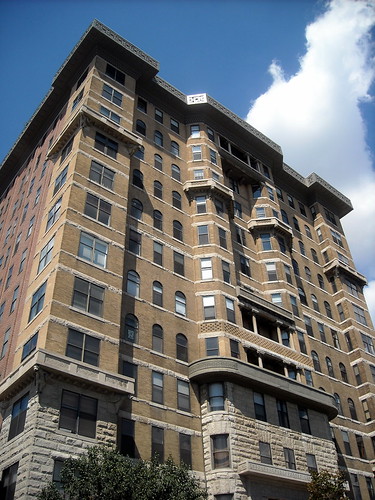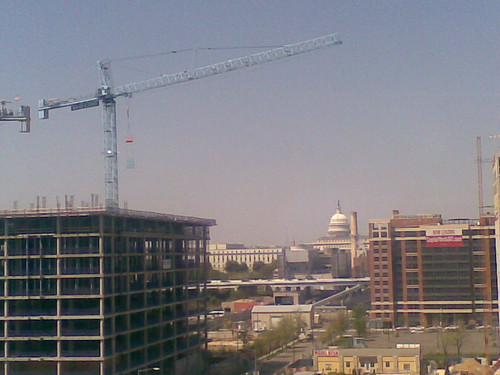courtesy of ‘NCinDC’
As an urban planner in DC, I cringe every time I hear a myth about the city (OMG, if I hear the “Pierre L’Enfant hated John Jay” reason for there being no J Streetone more time I’m going to scream). One of the most widespread myths I hear from out-of-towners and Washingtonians alike is that the height limit in DC states that no building can be taller than the dome of the Capitol, and that the limit was enacted to preserve views of the Capitol and Washington Monument. This is just plain wrong, and I’m here to tell you why.
Back in 1894, the Cairo apartment building was built on Q Street NW in Dupont Circle. At 14 stories tall, it was the tallest building in the city at that time, and some residents had concerns about it. Would it overwhelm the lower-density neighborhood? Was it structurally sound? Would existing fire-fighting equipment be able to reach top floors? Those last two questions were primarily the reason that Congress stepped in in 1899 to establish the Height of Buildings Act. Technology at the time was advancing quickly, but questions remained about the safety of such a tall building. Height limits at the time were fairly common in American cities, including Boston and Chicago.
The 1899 Height of Buildings Act established that no building could be taller than the Capitol (289 feet), but if that’s the case, why don’t we have a city full of 28-story buildings? Well, in 1910 the act was amended to restrict building heights even further: no building could be more than twenty feet taller than the width of the street that it faces. So, a building on a street with an 80-foot right-of-way could only be 100 feet, or 10 stories. This preserved the “light and airy” character of Washington that Thomas Jefferson envisioned. This 1910 law is still in effect today, and it essentially means that no building can be taller than about 13 stories (with the exception of Pennsylvania Avenue, which is zoned in some places to allow buildings of up to 160 feet).
courtesy of ‘brownpau’
Today we DC residents are lucky that we live in a human-scale city without the wind tunnels and shadowed streets that other cities have. There are no huge expanses of surface parking lots downtown (with one notable exception), because the value of land is so high. Rooftop decks provide beautiful vistas of the city, and yes, you can see the Washington Monument and the Capitol dome from many places. However, it’s also true that the height limit is artificially raising rents downtown (DC’s downtown real estate value is second only to Manhattan), constraining development and therefore limiting tax revenue to DC, and that many companies are being pushed out to Arlington or Bethesda, where skyscrapers are allowed. And the restrictions on building heights near Metro stations seems counter-intuitive to the tenets of transit-oriented development. But I’ll leave the debate over the height limit to the Washington Post and the real estate guys and the worriers and the urban planners.
So now you know– the height limit has nothing to do with being able to see the Capitol dome from anywhere in the city. In fact, there are three buildings (not counting the Washington Monument) in the city today that are taller than the Capitol. First commenter to correctly guess all three gets my congratulations and respect– I could only think of one!
Update: I love how many commenters are sharing their opinions on this! It’s really an issue that people feel strongly about, and there are really compelling arguments on both sides. I wanted to address the issue of how sure I was that the original height act was there for fire and safety reasons, and to answer: I’m pretty sure. I first learned about it in September of last year at a lecture at the National Building Museum on the Height Limit, which you can listen to online. There are also a number of online sources that back me up: the planning website Planetizen describes the fire-fighting issue, while DesignCult describes the technology and safety issues. Surveyor Wendy Lathrop describes both the fire hazards and the building material and structural concerns that inspired height limits at the time. If you’re interested in the history of height limits in general, I’d recommend reading Chapter 3 (“The Sacred Skyline”) of Robert Fogelson’s book Downtown: Its Rise and Fall.
As it turns out, many cities had height limits at the turn of the century, but the District’s was never repealed and it became a distinctive feature of the urban landscape. Why was it never repealed? Possibly because people really liked the “light and airy” character that Thomas Jefferson envisioned, possibly because after the advent of rooftop decks, District residents loved their views, or possibly because it would require an act of Congress to change it. Either way, it has become ingrained in DC’s culture, and it looks like it’s here to stay.


Pingback: Chicago Has A Washington Monument? « Daniel Strauss
DC is probably the only city where you can find more office space within a 1 mile radius outside of the city than you can find in the city. I’m all for lifting the height restriction.
Wonder, unscientifically, whether the height limit is the reason we don’t have anywhere near the glut of condos/apts that a place like Miami has right now. Obviously, DC doesn’t have a Miami waterfront, but it does have your average developers, who if they’re going to build 30 stories might as well build 50 or 60.
Even without height restrictions, the wonderful world of zoning FAR (Floor/Area Ratio) would keep monstrous towers from exploding everywhere. Granted, some developers could purchase the FAR of surrounding buildings and areas to increase their own build capacity, but the DC Zoning Commission could smack those transfers down pretty quickly as well.
I for one like the height restriction. And I’d say the office space in Virginia is more because of cost per square foot and tax issues in DC as opposed to height limitations.
http://dcoz.dc.gov/faqs/faq.asp#91
I say build skyscrapers in DC this city skyline looks like crap to me and I grew up here been here all my life and this is comming from a 24yr old. I think that when the old people die off and and its just us young people left (although we won’t be young in the future) DC will look so different and it will prob be a fun place to live. And yes I am moving, I already know what some of you are going to say.
Pingback: Amanita.net » Blog Archive » Daily Digest for January 5th
I’ve lived here 30+ years – the story I remember hearing about the height restriction had to do with penny-pinching Congress not wanting to have to spend money on new fire equipment whenever someone else would build a new tallest building in the city. And from what I heard about the way Congress treated the city during most of the 20th century before Home Rule, that makes perfect sense to me.
Pingback: DC Mythbusting « these vibes are too cosmic
Nice thinking but I do believe that any time a property is built in somewhere like DC there is ALWAYS another innuendo. I bet the views are beautiful from the top though lol
Nice work Kevin!